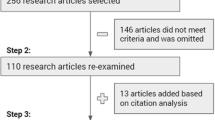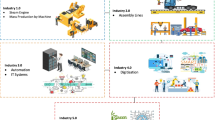Abstract
Product platform planning can greatly support product variant design, which is of great help to the implementation of mass customization (MC). In most of product platform planning methods, product modules and product families have been usually preplanned before products are designed, which would not make full use of the existing product resources. In this paper, we propose a method for product platform planning using the existing product data in product lifecycle management (PLM) database. The proposed method introduces two key technologies, i.e., pruning analysis and attribute matching. The pruning analysis is used to find out the sharing parts of different product families, which constitutes the basic framework of product platform; the attribute matching is used to classify product modules into different categories according to their sharing degrees, which reveals the relationships of different product modules and forms the association rules of product platform. The effectiveness of the proposed method is verified by the product data in the PLM database of a valve company. The proposed method greatly improves the reuse rate of existing product resources, providing an effective and fast way for enterprises to implement the MC strategy.












Similar content being viewed by others
Abbreviations
- PLM:
-
Product lifecycle management
- MC:
-
Mass customization
- BOM:
-
Bill of material
- PST:
-
Product structure tree
- PFSTs:
-
Product family structure trees
- BM:
-
Basic module
- MuM:
-
Must-selected module
- MaM:
-
May-selected module
- PrM:
-
Private product module
- FSM:
-
Families sharing product module
- SSM:
-
Series sharing product module
- GSM:
-
Global sharing product module
- LCISF:
-
Longest consecutive identical structure segment from the first node
- \(P^{m}\) :
-
Product series \(m, m\in N^{+}\)
- \(PF_{Ni}^{i}\) :
-
Product family \(N_{i}\) of product series \(P^{i}, N_i \in N^{+}\)
- N :
-
The total number of product family in an enterprise
- \(Tr_{Nk}^{k}\) :
-
Product family structure tree \(N_{k}\), of product series \(P^{k}\)
- \(Ta_{Nk}^{k}\) :
-
Product structure chain table \(N_{k}\), of product series \(P^{k}\)
- \(Tr_{\mathrm{min}}\) :
-
Minimum structure tree
- \(L_{n}\) :
-
Structure chain \(n, n\in N^{+}\)
- \(f_{n}\) :
-
The code of function \(n, n\in N^{+}\)
- \(M_{n}^{i}\) :
-
Product module n of product series \(P^{i}\)
- \(PrM^{i}\) :
-
The PrMs of product series \(P^{i}\)
- \(FSM^{i}\) :
-
The FSMs of product series \(P^{i}\)
- \(SSM^{i}\) :
-
The SSMs of product series \(P^{i}\)
- \(F_{i}\) :
-
The function code of product module \(M_{i}\)
- S / F / P :
-
The structure/function/process parameter of a product module
References
André, S., Stolt, R., & Elgh, F. (2015). Introducing design descriptions on different levels of concretisation in a platform definition. In IFIPInternational conference on product lifecycle management (pp. 800–810). Springer International Publishing.
Anzanello, M. J., & Fogliatto, F. S. (2011). Selecting the best clustering variables for grouping mass-customized products involving workers’ learning. International Journal of Production Economics, 130(2), 268–276.
Aoki, M., & Ando, H. (2003). The times of module the essence of the new industrial structure. Shanghai: Shanghai Far East Press.
Bruun, H. P. L., Mortensen, N. H., & Harlou, U. (2013). PLM support for development of modular product families. In DS 75-4: Proceedings of the 19th international conference on engineering design (ICED13), design for harmonies, vol. 4: product, service and systems design, Seoul, Korea, 19–22 08 2013.
Bruun, H. P. L., Mortensen, N. H., Harlou, U., et al. (2015). PLM system support for modular product development. Computers in Industry, 67, 97–111.
Choi, T. M. (2013). Optimal return service charging policy for a fashion mass customization program. Service Science, 5(1), 56–68.
Chowdhury, S., Maldonado, V., Tong, W., et al. (2016). New modular product-platform-planning approach to design macroscale reconfigurable unmanned aerial vehicles. Journal of Aircraft, 53(2), 309–322.
Duray, R., Ward, P. T., Milligan, G. W., et al. (2000). Approaches to mass customization: Configurations and empirical validation. Journal of Operations Management, 18(6), 605–625.
Ebert, C. (2013). Improving engineering efficiency with PLM/ALM. Software and Systems Modeling, 12(3), 443–449.
Fan, B. B., Qi, G., Hu, X., et al. (2015). A network methodology for structure-oriented modular product platform planning. Journal of Intelligent Manufacturing, 26(3), 553–570.
Ferre, M., Puig, A., & Tost, D. (2004). A fast hierarchical traversal strategy for multimodal visualization. In Electronic Imaging 2004 (pp. 1–13). International Society for Optics and Photonics.
Gao, F., Xiao, G., & Simpson, T. W. (2009). Module-scale-based product platform planning. Research in Engineering Design, 20(2), 129–141.
Jensen, K. N., Nielsen, K., & Brunoe, T. D. (2015). Application of mass customization in the construction industry. In IFIP international conference on advances in production management systems (pp. 161–168). Springer International Publishing.
Jiao, J. R., Zhang, L. L., Pokharel, S., & He, Z. (2007). Identifying generic routings for product families based on text mining and tree matching. Decision Support Systems, 43(3), 866–883.
Jiao, J., & Tseng, M. M. (1999). A methodology of developing product family architecture for mass customization. Journal of Intelligent Manufacturing, 10(1), 3–20.
Kintner, H. J. (2007). Representation and analysis challenges in design for part-reuse: An automotive case study. In ASME 2007 international design engineering technical conferences and computers and information in engineering conference (pp. 611–619). American Society of Mechanical Engineers.
Lee, H. H., & Moon, H. (2015). Perceived risk of online apparel mass customization scale development and validation. Clothing and Textiles Research Journal, 33(2), 115–128.
Levandowski, C. E., Corin-Stig, D., Bergsjö, D., Forslund, A., Högman, U., Söderberg, R., et al. (2013a). An integrated approach to technology platform and product platform development. Concurrent Engineering, 21(1), 65–83.
Levandowski, C., Forslund, A., Söderberg, R., & Johannesson, H. (2013b). Using PLM and trade-off curves to support set-based convergence of product platforms. In 19th international conference on engineering design–ICED 2013.
Li, Z., Pehlken, A., Qian, H., & Hong, Z. (2016). A systematic adaptable platform architecture design methodology for early product development. Journal of Engineering Design, 27(1–3), 93–117.
Liu, W., Liu, Z. Y., & Tan, J. R. (2010). Construction of product modules based on process similarity. Journal of Computer-Aided Design and Computer Graphics, 22(10), 1647–1654. (in Chinese).
Liu, X. Y., Huang, M. F., Liu, F. Y., & Deng, X. L. (2009). Research and realization of the product family structure tree based on complex network. Microelectronics and Computer, 26(11), 177–180.
McIntosh, R. I., Matthews, J., Mullineux, G., & Medland, A. J. (2010). Late customisation: Issues of mass customisation in the food industry. International Journal of Production Research, 48(6), 1557–1574.
Meyer, M. H., & Lehnerd, A. P. (1997). The power of product platforms: Building value and cost leadership. Research Technology Management, 40(6), 526–529.
Ming, X. G., Yan, J. Q., Lu, W. F., Ma, D. Z., & Song, B. (2007). Mass production of tooling product families via modular feature-based design to manufacturing collaboration in PLM. Journal of Intelligent Manufacturing, 18(1), 185–195.
Navarrete, I. A., & Guzmán, A. A. L. (2013). Reduction of product platform complexity by vectorial Euclidean algorithm. Journal of Mechanical Science and Technology, 27(11), 3371–3379.
Nelson, S. A., Parkinson, M. B., & Papalambros, P. Y. (2001). Multicriteria optimization in product platform design. Journal of Mechanical Design, 123(2), 199–2.
Ojamaa, A., Kotkas, V., Spichakova, M., & Penjam, J. (2013). Developing a lean mass customization based manufacturing. In 2013 IEEE 16th international conference on computational science and engineering (CSE) (PP. 28–33). IEEE.
Ostrosi, E., Stjepandić, J., Fukuda, S., & Kurth, M. (2014, September). Modularity: New trends for product platform strategy support in concurrent engineering. In Proceedings of the 21st ISPE international conference on concurrent engineering (pp. 414–423).
Pearl, J. (1986). Fusion, propagation, and structuring in belief networks. Artificial intelligence, 29(3), 241–288.
Pedersen, K., Messer, M., Allen, J. K., & Mistree, F. (2013). Hierarchical product platform design: A domain-independent approach. Ships and Offshore Structures, 8(3–4), 367–382.
Qu, T., Bin, S., Huang, G. Q., & Yang, H. D. (2011). Two-stage product platform development for mass customisation. International Journal of Production Research, 49(8), 2197–2219.
Sharafat, A. R., & Ma, O. R. (2006). Recursive contraction algorithm: A novel and efficient graph traversal method for scanning all minimal cut sets. Iranian Journal of Science and Technology, 30(B6), 749–761.
Wang, H., & Chen, B. (2013). Intrusion detection system based on multi-strategy pruning algorithm of the decision tree. In Proceedings of 2013 IEEE international conference on grey systems and intelligent services (GSIS) (pp. 445–447). IEEE.
Xu, Y., Chen, G., & Zheng, J. (2016). An integrated solution-KAGFM for mass customization in customer-oriented product design under cloud manufacturing environment. International Journal of Advanced Manufacturing Technology, 84(1–4), 85–101.
Xu, Y., Chen, Y., Xu, Q., & Hou, L. (2004). Generalized modular design method for durable product customization. In Proceeding of the 11th world congress in mechanism and machine science.
Zhang, L. L. (2015). A literature review on multitype platforming and framework for future research. International Journal of Production Economics, 168, 1–12.
Zhang, M., Li, G. X., Cao, J., Gong, J., & Wu, B. (2016). A bottom-up method for module-based product platform development through mapping, clustering and matching analysis. Journal of Central South University, 23(3), 623–635.
Zhang, W. L., Fan, Y. S., & Yin, C. W. (2006). Approach of product configuration based on product family genealogy. Computer Integrated Manufacturing Systems, 12(11), 1741–1746.
Zhao, L. X., Jiang, P., Wang, X. Y., Ding, J. G., & Tan, R. H. (2007). A method of optimum product platform parameters planning. In 2007 IEEE international conference on industrial engineering and engineering management (pp. 382–386). IEEE.
Zhou, F., Ji, Y., & Jiao, R. J. (2013). Affective and cognitive design for mass personalization: Status and prospect. Journal of Intelligent Manufacturing, 24(5), 1047–1069.
Acknowledgements
Funding was provided by National Natural Science Foundation of China (Grant no. 51275362), National Science and Technology Major Projetcs (Grant no. 2014ZX04015021).
Author information
Authors and Affiliations
Corresponding author
Rights and permissions
About this article
Cite this article
Zhang, Q., Peng, W., Lei, J. et al. A method for product platform planning based on pruning analysis and attribute matching. J Intell Manuf 30, 1069–1083 (2019). https://doi.org/10.1007/s10845-017-1305-7
Received:
Accepted:
Published:
Issue Date:
DOI: https://doi.org/10.1007/s10845-017-1305-7




